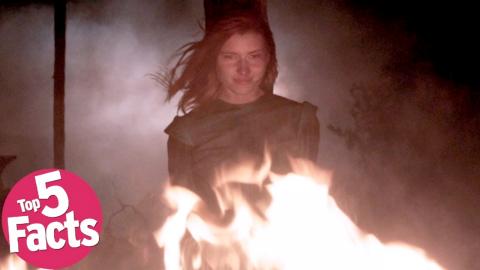Top 5 Shocking Facts about the Salem Witch Trials

#5: A Fungus Was to Blame
In the early spring of 1692, panic struck after two young girls began suffering hallucinations. The local doctor concluded witchcraft was to blame. The ensuing witch-hunt became legendary. So, what happened? It seemed to be spontaneous madness. But in the 1970s, Linnda Caporael of U.C. Santa Barbara made a brilliant discovery when she linked the afflicted “victims” symptoms to ergot poisoning. This fungus infects rye, and a by-product of the infection is ergotamine – basically LSD. The excessive rain of the previous summer provided perfect conditions for the fungus to grow. The affected grain had been harvested in the autumn, and eaten the following spring. Not witchcraft, just a very bad trip.
#4: Children Made The Most Accusations
After two girls, Elizabeth Parris and Abigail Williams, took to their initial fits, many other young girls claimed to have been bewitched. One of the most aggressive accusers was twelve-year-old Ann Putnam Jr.; her name appears over 400 times in the court documents of the trials, and eleven of the nineteen people she accused were hanged. It seems Putnam, along with her friends, did the lion share of accusing. And because of their age, the judges believed that they were innocent and honest, and virtually no evidence was needed to back their claims – which could include bad dreams, or “spectral evidence” as proof.
#3: The Trials Were Deeply Regretted
By the end of the year, the true horror of the trials began to dawn on the small New England community. It seemed impossible to go back to normal. The shame of the murders haunted the town for years, taking more than just a psychological toll. Because the town had spent the summer engrossed in wild proceedings, harvest work had not been completed. There was less food, and their economy took a major hit. Believing that they were being punished by God, in January 1697 the Massachusetts General Court ordered a day of fasting, and the 12 jurors signed a Declaration of Regret, asking forgiveness. In 1706, a repentant Ann Putnam finally confessed to lying.
#2: Burning Was Not the Standard Method of Execution
Actually, Sir Bedevere, in Salem those executed for witchcraft were all hanged – with the exception of the last man, Giles Corey. Refusing to enter a plea of guilty or not guilty, the court ordered him to be crushed with stones – a form of torture to extract a plea. The crushing took place in a field beside the courthouse. It lasted two days. When asked again for his plea a last time, he responded, “More weight!” and died. The gruesome death of the old man is said to be the shock that jolted the town out of its mania, and the trials were suspended thereafter.
#1: Not Only Women Were Accused
When most people think of a witch these days, they often think of women – young or old. But back in 1692, anyone could be accused of witchcraft – even animals. While the majority of those murdered were women, of the nineteen convicted and hanged, three were men. John Willard, Samuel Wardwell, and John Proctor were all convicted of witchcraft, and hanged; another, Giles Corey – as previously noted – gave no plea, and was crushed to death. Many other men and women were accused but some escaped, evaded arrest, or died in prison awaiting trial.